
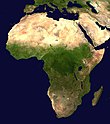
Africa
Africa is the world's second-largest and second most-populous continent, after Asia. At about 30,221,532 km² (11,668,599 sq mi) including adjacent islands, it covers 20.4% of the Earth's total land area, and with over 900 million inhabitants in 61 territories, it accounts for about 14% of the world's human population. Modern human evolutionary theory recognizes Africa, particular the area in and around present-day Ethiopia, as the cradle of humankind.
The continent is surrounded by the Mediterranean Sea to the north, the Suez Canal and the Red Sea to the northeast, the Indian Ocean to the southeast, and the Atlantic Ocean to the west. It straddles the equator and encompasses numerous climate areas and is the only continent to stretch from the northern temperate to southern temperate zones. Because of the lack of natural regular precipitation and irrigation as well as glaciers or mountain aquifer systems, there no natural moderating effect on the climate exists except near the coasts.
Etymology
Afri was a Latin name used to refer to the Carthaginians who dwelt in North Africa in modern-day Tunisia. Their name is usually connected with Phoenician afar, "dust", but a 1981 hypothesis has asserted that it stems from the Berber word ifri or ifran meaning "cave" and "caves", in reference to cave dwellers. Africa or Ifri or Afer is the name of Banu Ifran from Algeria and Tripolitania (Berber Tribe of Yafran).Under Roman rule, Carthage became the capital of Africa Province, which also included the coastal part of modern Libya. The Latin suffix "-ica" can sometimes be used to denote a land (e.g., in Celtica from Celtes, as used by Julius Caesar). The later Muslim kingdom of Ifriqiya, modern-day Tunisia, also preserved a form of the name.
Other etymological hypotheses that have been postulated for the ancient name "Africa":
- the 1st century Jewish historian Flavius Josephus (Ant. 1.15) asserted that it was named for Epher, grandson of Abraham according to Gen. 25:4, whose descendants, he claimed, had invaded Libya.
- Latin word aprica ("sunny") mentioned by Isidore of Seville in Etymologiae XIV.5.2.
- the Greek word aphrike (Αφρική), meaning "without cold." This was proposed by historian Leo Africanus (1488–1554), who suggested the Greek word phrike (φρίκη, meaning "cold and horror"), combined with the privative prefix "a-", thus indicating a land free of cold and horror.
- Massey, in 1881, derived an etymology from the Egyptian af-rui-ka, "to turn toward the opening of the Ka." The Ka is the energetic double of every person and "opening of the Ka" refers to a womb or birthplace. Africa would be, for the Egyptians, "the birthplace."
- yet another hypothesis was proposed by Michèle Fruyt in Revue de Philologie 50, 1976: 221–238, linking the Latin word with africus 'south wind', which would be of Umbrian origin and mean originally 'rainy wind'.
Paleohistory
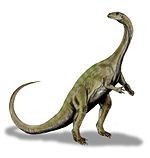
Early Jurassic strata are distributed in a similar fashion to Late Triassic beds, with more common outcrops in the south and less common fossil beds which are predominated by tracks to the north. As the Jurassic proceeded, larger and more iconic groups of dinosaurs like sauropods and ornithopods proliferated in Africa. Middle Jurassic strata are neither well represented nor well studied in Africa. Late Jurassic strata are also poorly represented apart from the spectacular Tendaguru fauna in Tanzania. The Late Jurassic life of Tendaguru is very similar to that found in western North America's Morrison Formation.
Midway through the Mesozoic, about 150–160 million years ago, Madagascar separated from Africa, although it remained connected to India and the rest of the Gondwanan landmasses. Fossils from Madagascar include abelisaurs and titanosaurs.

By contrast to Madagascar, mainland Africa was relatively stable in position through-out the Mesozoic. Despite the stable position, major changes occurred to its relation to other landmasses as the remains of Pangea continued to break apart. By the beginning of the Late Cretaceous epoch South America had split off from Africa, completing the southern half of the Atlantic Ocean. This event had a profound effect on global climate by altering ocean currents.
During the Cretaceous, Africa was populated by allosauroids and spinosaurids, including the largest known carnivorous dinosaurs. Titanosaurs were significant herbivores in its ancient ecosystems. Cretaceous sites are more common than Jurassic ones, but are often unable to be dated radiometrically making it difficult to know their exact ages. Paleontologist Louis Jacobs, who spent time doing field work in Malawi, says that African beds are "in need of more field work" and will prove to be a "fertile ground ... for discovery."
Pre-history

Throughout humanity's prehistory, Africa (like all other continents) had no nation states, and was instead inhabited by groups of hunter-gatherers such as the Khoi and San.
At the end of the Ice Ages, estimated to have been around 10,500 BC, the Sahara had again become a green fertile valley, and its African populations returned from the interior and coastal highlands in Sub-Saharan Africa]. However, the warming and drying climate meant that by 5000 BC the Sahara region was becoming increasingly dry and hostile. The population trekked out of the Sahara region towards the Nile Valley below the Second Cataract where they made permanent or semi-permanent settlements. A major climatic recession occurred, lessening the heavy and persistent rains in Central and Eastern Africa. Since this time dry conditions have prevailed in Eastern Africa, and increasingly during the last 200 years, in Ethiopia.
The domestication of cattle in Africa preceded agriculture and seems to have existed alongside hunter-gathering cultures. It is speculated that by 6000 BC cattle were already domesticated in North Africa. In the Sahara-Nile complex, people domesticated many animals including the donkey, and a small screw-horned goat which was common from Algeria to Nubia. In the year 4000 BC the climate of the Sahara started to become drier at an exceedingly fast pace. This climate change caused lakes and rivers to shrink significantly and caused increasing desertification. This, in turn, decreased the amount of land conducive to settlements and helped to cause migrations of farming communities to the more tropical climate of West Africa.
By the first millennium BC ironworking had been introduced in Northern Africa and quickly spread across the Sahara into the northern parts of sub-Saharan Africa and by 500 BC metalworking began to become commonplace in West Africa. Ironworking was fully established by roughly 500 BC in many areas of East and West Africa, although other regions didn't begin ironworking until the early centuries AD. Copper objects from Egypt, North Africa, Nubia and Ethiopia dating from around 500 BC have been excavated in West Africa, suggesting that trans-saharan trade networks had been established by this date.
Early civilizations
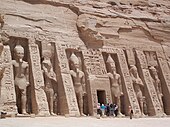
An independent centre of civilisation with trading links to Phoenicia was established by Phoenicians from Tyre on the north-west African coast at Carthage.
European exploration of Africa began with Ancient Greeks and Romans. In 332 BC, Alexander the Great was welcomed as a liberator in Persian-occupied Egypt. He founded Alexandria in Egypt, which would become the prosperous capital of the Ptolemaic dynasty after his death. Following the conquest of North Africa's Mediterranean coastline by the Roman Empire, the area was integrated economically and culturally into the Roman system. Roman settlement occurred in modern Tunisia and elsewhere along the coast. Christianity spread across these areas from Palestine via Egypt, also passing south, beyond the borders of the Roman world into Nubia and by at least the 6th century into Ethiopia.
In the early 7th century, the newly formed Arabian Islamic Caliphate expanded into Egypt, and then into North Africa. In a short while the local Berber elite had been integrated into Muslim Arab tribes. When the Ummayad capital Damascus fell in the 8th century, the Islamic center of the Mediterranean shifted from Syria to Qayrawan in North Africa. Islamic North Africa had become diverse, and a hub for mystics, scholars, jurists and philosophers. During the above mentioned period, Islam spread to sub-Saharan Africa, mainly through trade routes and migration.
9th–18th century
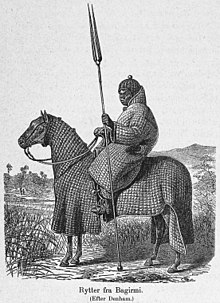
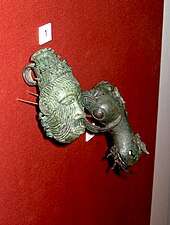
By the 9th century a string of dynastic states, including the earliest Hausa states, stretched across the sub-saharan savannah from the western regions to central Sudan. The most powerful of these states were Ghana, Gao, and the Kanem-Bornu Empire. Ghana declined in the 11th century but was succeeded by the Mali Empire which consolidated much of western Sudan in the 13th century. Kanem accepted Islam in the 11th century.
In the forested regions of the West African coast, independent kingdoms grew up with little influence from the Muslim north. The Kingdom of Nri of the Igbo was established around the 9th century and was one of the first. It is also one of the oldest Kingdom in modern day Nigeria and was ruled by the Eze Nri. The Nri kingdom is famous for its elaborate bronzes, found at the town of Igbo Ukwu. The bronzes have been dated from as far back as the 9th century.
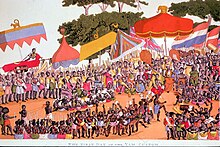
The Almoravids were a Berber dynasty from the Sahara that spread over a wide area of northwestern Africa and the Iberian peninsula during the 11th century. The Banu Hilal and Banu Ma'qil were a collection of Arab Bedouin tribes from the Arabian peninsula who migrated westwards via Egypt between the 11th and 13th centuries. Their migration resulted in the fusion of the Arabs and Berbers, where the locals were Arabized, and Arab culture absorbed elements of the local culture, under the unifying framework of Islam.

Height of slave trade

In West Africa, the decline of the Atlantic slave trade in the 1820s caused dramatic economic shifts in local polities. The gradual decline of slave-trading, prompted by a lack of demand for slaves in the New World, increasing anti-slavery legislation in Europe and America, and the British Royal Navy's increasing presence off the West African coast, obliged African states to adopt new economies. Between 1808 and 1860, the British West Africa Squadron seized approximately 1,600 slave ships and freed 150,000 Africans who were aboard.
Action was also taken against African leaders who refused to agree to British treaties to outlaw the trade, for example against "the usurping King of Lagos", deposed in 1851. Anti-slavery treaties were signed with over 50 African rulers. The largest powers of West Africa (the Asante Confederacy, the Kingdom of Dahomey, and the Oyo Empire) adopted different ways of adapting to the shift. Asante and Dahomey concentrated on the development of "legitimate commerce" in the form of palm oil, cocoa, timber and gold, forming the bedrock of West Africa's modern export trade. The Oyo Empire, unable to adapt, collapsed into civil wars.
Colonialism and the "Scramble for Africa"

Belgium
Germany
Spain
France
United Kingdom
Italy
Portugal
independent
Berlin Conference
The Berlin Conference held in 1884–85 was an important event in the political future of African ethnic groups. It was convened by King Leopold II of Belgium, and attended by the European powers that laid claim to African territories. It sought to bring an end to the Scramble for Africa by European powers by agreeing on political division and spheres of influence. They set up the political divisions of the continent, by spheres of interest, that exist in Africa today.Independence struggles
Imperial rule by Europeans would continue until after the conclusion of World War II, when almost all remaining colonial territories gradually obtained formal independence. Independence movements in Africa gained momentum following World War II, which left the major European powers weakened. In 1951, Libya, a former Italian colony, gained independence. In 1956, Tunisia and Morocco won their independence from France. Ghana followed suit the next year (March 1957), becoming the first of the sub-Saharan colonies to be freed. Most of the rest of the continent became independent over the next decade.Portugal's overseas presence in Sub-Saharan Africa (most notably in Angola, Cape Verde, Mozambique, Guinea-Bissau and São Tomé and Príncipe) lasted from the 16th century to 1975, after the Estado Novo regime was overthrown in a military coup in Lisbon. Rhodesia unilaterally declared independence from the United Kingdom in 1965, under the white minority government of Ian Smith, but was not internationally recognised as an independent state (as Zimbabwe) until 1980, when black nationalists gained power after a bitter guerrilla war. Although South Africa was one of the first African countries to gain independence, the state remained under the control of the country's white minority through a system of racial segregation known as apartheid until 1994.
Post-colonial Africa
Today, Africa contains 54 sovereign countries, most of which still have the borders drawn during the era of European colonialism. Since colonialism, African states have frequently been hampered by instability, corruption, violence, and authoritarianism. The vast majority of African states are republics that operate under some form of the presidential system of rule. However, few of them have been able to sustain democratic governments on a permanent basis, and many have instead cycled through a series of coups, producing military dictatorships.Great instability was mainly the result of marginalization of ethnic groups, and graft under these leaders. For political gain, many leaders fanned ethnic conflicts that had been exacerbated, or even created, by colonial rule. In many countries, the military was perceived as being the only group that could effectively maintain order, and it ruled many nations in Africa during the 1970s and early 1980s. During the period from the early 1960s to the late 1980s, Africa had more than 70 coups and 13 presidential assassinations. Border and territorial disputes were also common, with the European-imposed borders of many nations being widely contested through armed conflicts.
Cold War conflicts between the United States and the Soviet Union, as well as the policies of the International Monetary Fund, also played a role in instability. When a country became independent for the first time, it was often expected to align with one of the two superpowers. Many countries in Northern Africa received Soviet military aid, while many in Central and Southern Africa were supported by the United States, France or both. The 1970s saw an escalation, as newly independent Angola and Mozambique aligned themselves with the Soviet Union, and the West and South Africa sought to contain Soviet influence by funding insurgency movements. There was a major famine in Ethiopia, when hundreds of thousands of people starved. Some claimed that Marxist/Soviet policies made the situation worse.
The most devastating military conflict in modern independent Africa has been the Second Congo War. By 2008, this conflict and its aftermath had killed 5.4 million people. Since 2003 there has been an ongoing conflict in Darfur which has become a humanitarian disaster. AIDS has also been a prevalent issue in post-colonial Africa.
Geography

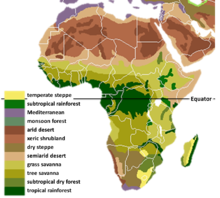
Africa's largest country is Algeria, and its smallest country is the Seychelles, an archipelago off the east coast. The smallest nation on the continental mainland is The Gambia.
According to the ancient Romans, Africa lay to the west of Egypt, while "Asia" was used to refer to Anatolia and lands to the east. A definite line was drawn between the two continents by the geographer Ptolemy (85–165 AD), indicating Alexandria along the Prime Meridian and making the isthmus of Suez and the Red Sea the boundary between Asia and Africa. As Europeans came to understand the real extent of the continent, the idea of Africa expanded with their knowledge.
Geologically, Africa includes the Arabian Peninsula; the Zagros Mountains of Iran and the Anatolian Plateau of Turkey mark where the African Plate collided with Eurasia. The Afrotropic ecozone and the Saharo-Arabian desert to its north unite the region biogeographically, and the Afro-Asiatic language family unites the north linguistically.
Climate

Fauna

Main article: Fauna of Africa
Africa boasts perhaps the world's largest combination of density and "range of freedom" of wild animal populations and diversity, with wild populations of large carnivores (such as lions, hyenas, and cheetahs) and herbivores (such as buffalo, elephants, camels, and giraffes) ranging freely on primarily open non-private plains. It is also home to a variety of "jungle" animals including snakes and primates and aquatic life such as crocodiles and amphibians. In addition, Africa has the largest number of megafauna species, as it was least affected by the extinction of the Pleistocene megafauna. Data Science Ar
Data Science Ar
0 comments:
Post a Comment